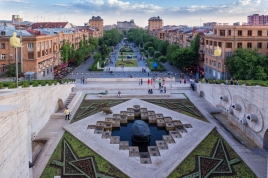Yerevan
Thursday, December 23, 2021
Yerevan is the capital and largest city of Armenia and one of the world's oldest continuously inhabited cities.
Situated along the Hrazdan River, Yerevan is the administrative, cultural, and industrial center of the country. It has been the capital since 1918, the fourteenth in the history of Armenia and the seventh located in or around the Ararat plain. The city also serves as the seat of the Araratian Pontifical Diocese; the largest diocese of the Armenian Apostolic Church and one of the oldest dioceses in the world.
The history of Yerevan dates back to the 8th century BC, with the founding of the fortress of Erebuni in 782 BC by King Argishti I at the western extreme of the Ararat plain. Erebuni was "designed as a great administrative and religious centre, a fully royal capital." By the late ancient Armenian Kingdom, new capital cities were established and Yerevan declined in importance. Under Iranian and Russian rule, it was the center of the Erivan Khanate from 1736 to 1828 and the Erivan Governorate from 1850 to 1917, respectively. After World War I, Yerevan became the capital of the First Republic of Armenia as thousands of survivors of the Armenian genocide in the Ottoman Empire arrived in the area. The city expanded rapidly during the 20th century as Armenia became part of the Soviet Union. In a few decades, Yerevan was transformed from a provincial town within the Russian Empire to Armenia's principal cultural, artistic, and industrial center, as well as becoming the seat of national government.
With the growth of the Armenian economy, Yerevan has undergone major transformation. Much construction has been done throughout the city since the early 2000s, and retail outlets such as restaurants, shops, and street cafés, which were rare during Soviet times, have multiplied. As of 2011, the population of Yerevan was 1,060,138, just over 35% of Armenia's total population. According to the official estimate of 2016, the current population of the city is 1,073,700. Yerevan was named the 2012 World Book Capital by UNESCO. Yerevan is an associate member of Eurocities.
Of the notable landmarks of Yerevan, Erebuni Fortress is considered to be the birthplace of the city, the Katoghike Tsiranavor church is the oldest surviving church of Yerevan and Saint Gregory Cathedral is the largest Armenian cathedral in the world, Tsitsernakaberd is the official memorial to the victims of the Armenian Genocide, and several opera houses, theatres, museums, libraries, and other cultural institutions. Yerevan Opera Theatre is the main spectacle hall of the Armenian capital, the National Gallery of Armenia is the largest art museum in Armenia and shares a building with the History Museum of Armenia, and the Matenadaran repository contains one of the largest depositories of ancient books and manuscripts in the world.
Yerevan has been the capital of Armenia since the independence of the First Republic in 1918. Situated in the Ararat plain, the historic lands of Armenia, it served as the best logical choice for capital of the young republic at the time.
When Armenia became a republic of the Soviet Union, Yerevan remained as capital and accommodated all the political and diplomatic institutions in the republic. In 1991 with the independence of Armenia, Yerevan continued with its status as the political and cultural centre of the country, being home to all the national institutions: the Government House, the National Assembly, the Presidential Palace, the Central Bank, the Constitutional Court, all ministries, judicial bodies and other government organizations.





